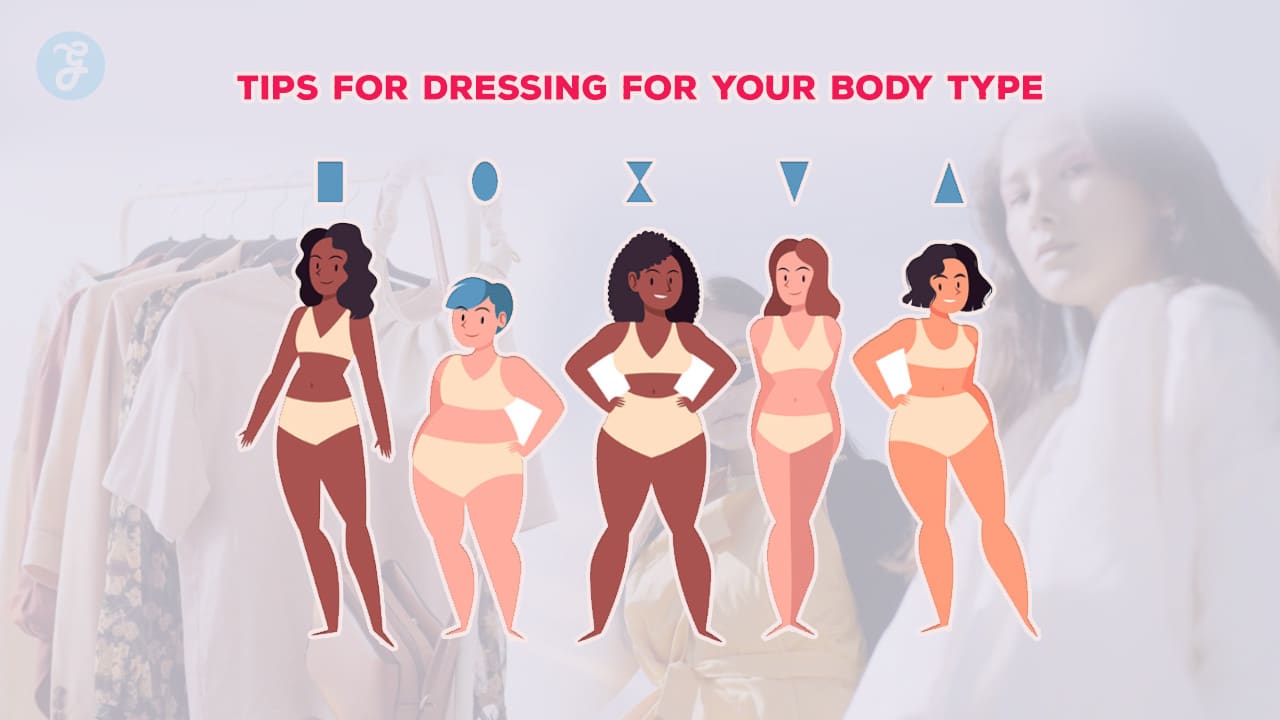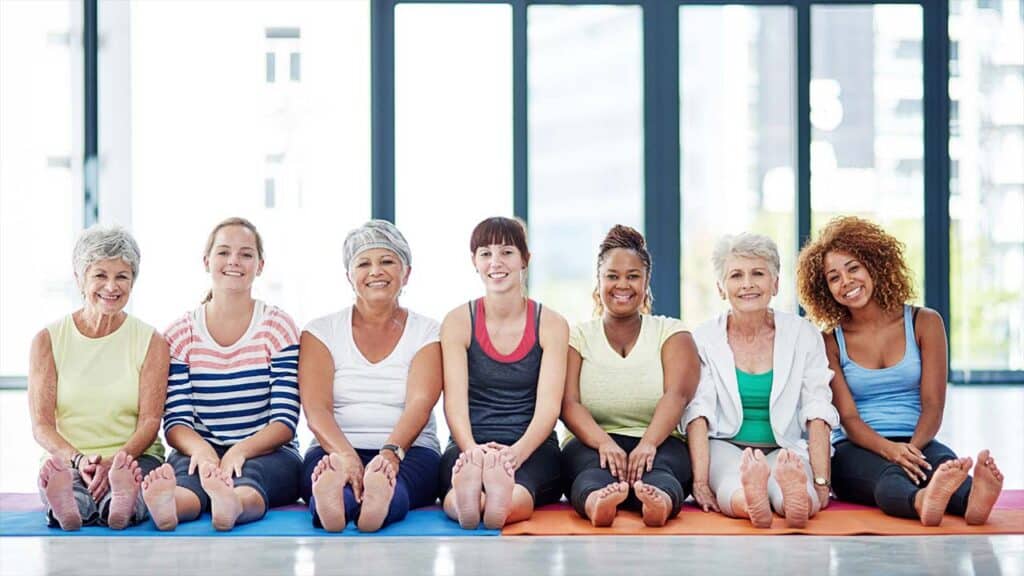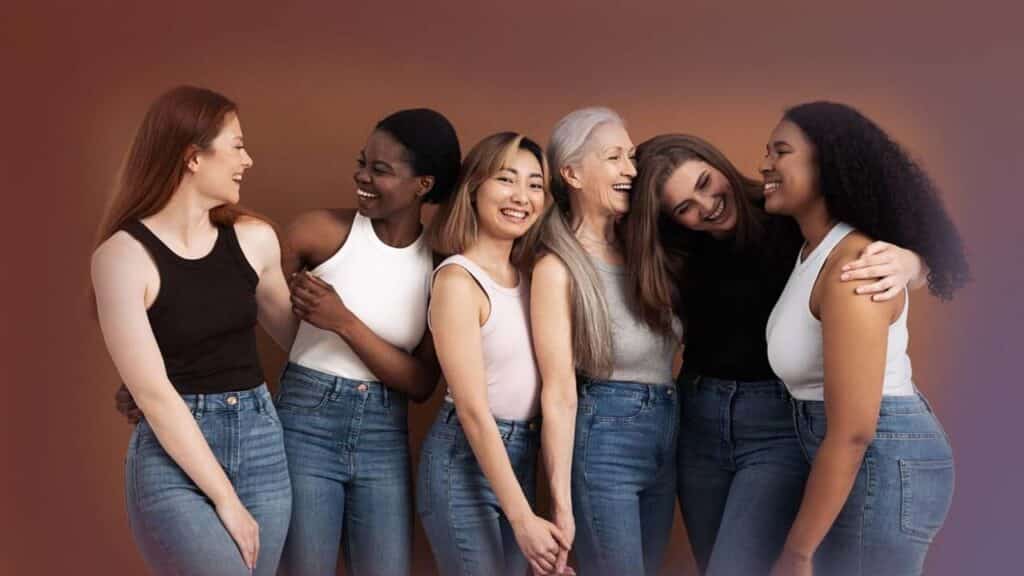Dressing for your body type can significantly affect how you look and feel. It’s all about finding clothes that flatter your unique shape and highlight your best features.
Understanding your body type lets you choose styles that enhance your natural silhouette and boost your confidence.
Learning to dress for your body type doesn’t mean following strict rules. It’s about experimenting with different cuts, fabrics, and proportions to find the best for you.
These tips will help you create outfits that make you feel great and showcase your style.
1. Understand Your Shape
Knowing your body shape is the first step to dressing well. Look at yourself in a full-length mirror. Notice your shoulders, waist, and hips.
Are your shoulders more comprehensive than your hips? You might have an inverted triangle shape. Do your hips and shoulders have about the same width? You could be a rectangle.
Your hips may be wider than your shoulders. This points to a pear shape. You’re likely an hourglass if you have a defined waist with balanced shoulders and hips.
Don’t worry if you don’t fit perfectly into one category. Many people are a mix of shapes. The goal is to get a general idea of your proportions.
Your body shape isn’t about size. It’s about how your body parts relate to each other. This helps you choose clothes that flatter your natural lines.
Remember, all shapes are beautiful. Understanding yours helps you pick outfits that make you feel confident and comfortable.
2. Embrace Your Curves
Curves are beautiful, so flaunt them with pride! Your body is unique, and your clothes should celebrate that. Pick outfits that hug your curves in all the right places.
Start with well-fitting undergarments. A good bra and shapewear can make a huge difference in how clothes look on you. They provide a smooth base for your outfits to shine.
Choose fabrics that drape nicely over your curves. Soft, stretchy materials like jerseys or knits are great options. They move with your body and feel comfortable all day long.
Look for tops and dresses that cinch at the waist. This highlights your natural shape and creates a flattering silhouette. Wrap dresses and peplum tops are perfect for this.
Don’t shy away from form-fitting clothes. A bodycon dress or skinny jeans can look amazing on curvy figures. Just ensure the fit is right – not too tight or loose.
Play with patterns and colors. Bold prints and bright hues can accentuate your curves in a fun way. Try vertical stripes to create a lengthening effect.
Remember, confidence is vital. When you feel good in your clothes, it shows. Pick outfits that make you feel fantastic and rock them with pride.
3. Highlight Your Waist
Your waist is a crucial feature to emphasize for a flattering look. Accentuating this area can create an hourglass shape and balance your proportions.
Choose tops and dresses that cinch at the waist. Look for styles with built-in waistbands or belts. These details draw the eye to your middle and create a definition.
Wrap dresses and tops are great options. They naturally hug your curves and tie at the waist. This style works well for many body types.
Try high-waisted bottoms paired with tucked-in tops. This combo creates a clear waistline and lengthens your legs. It’s a simple way to highlight your shape.
Belts are your secret weapon for waist definition. Add a slim belt to dresses, cardigans, or even over blazers. This trick instantly creates curves.
Avoid boxy or oversized tops that hide your waist. Instead, opt for fitted styles or those with subtle shaping at the midsection.
Peplum tops and dresses can also work wonders. The flared bottom half creates the illusion of a smaller waist and fuller hips.
Remember, the goal is to create a balanced silhouette. You’ll achieve a more proportionate look by drawing attention to your waist.
4. Avoid Baggy Clothes
Baggy clothes can hide your body shape and make you look bigger than you are. Opt for clothes that fit well and show off your figure.
Choose tops and bottoms that skim your body without being too tight. This will create a sleek look and highlight your best features.
Tailored pieces are your friends. A well-fitted blazer or pair of pants can make a big difference in your appearance.
If you like loose-fitting items, balance them with fitted pieces. For example, pair a flowy top with skinny jeans or leggings.
Pay attention to proportions. If you wear a loose top, go for a more fitted bottom, and vice versa.
Get your clothes altered if needed. A few minor adjustments can transform a baggy outfit into one that flatters your shape.
Remember, clothes that fit well will make you look and feel more confident. Don’t hide under excess fabric – show off your unique body type!
5. Choose the Right Undergarments
Picking the right underwear can make a big difference in how your clothes look and feel. Good undergarments create a smooth base for your outfits.
For a curvy figure, try high-waisted briefs or shapewear. These help smooth your tummy and hips. If you have a smaller chest, consider a padded bra to add some volume.
Pear-shaped bodies look great in boy shorts or hipster styles. These balance out your lower half. For apple shapes, seamless underwear prevents visible lines under clothes.
Athletic builds benefit from soft, stretchy fabrics. Look for breathable materials like cotton or modal. If you’re plus-sized, wide waistbands and full-coverage styles offer comfort and support.
Remember, comfort is vital. Avoid underwear that’s too tight or rides up. Well-fitting bras are a must – get measured regularly to ensure you’re wearing the correct size.
Don’t forget about color. Nude shades work well under light clothes. For darker outfits, you can have fun with patterns or brighter colors.
6. Wear V-Necklines
V-necklines are an excellent choice for many body types. They create a slimming effect by drawing the eye downward. This makes your neck look longer, and your upper body appears slimmer.
If you have a larger bust, V-necklines can help balance your proportions. They show just enough skin without being too revealing. For smaller busts, V-necks can create the illusion of more curves.
V-necklines work well for both casual and formal outfits. You can find them on t-shirts, sweaters, dresses, and blouses. Try different depths of V-necks to see what feels most comfortable for you.
When choosing a V-neck, make sure it fits nicely across your chest. A gaping neckline can be unflattering and uncomfortable. Layer a camisole underneath if you’re concerned about showing too much skin.
Accessorize your V-neck with a necklace that follows the neckline’s shape. This draws attention to your face and complements the V shape nicely. Avoid chunky necklaces above the V, as they can clash with the neckline.
7. Opt for A-line Dresses
A-line dresses are an excellent choice for many body types. They can flatter your figure and make you feel confident.
These dresses are more comprehensive at the bottom than at the top. This shape creates a smooth line from your shoulders to your hem.
A-line dresses can hide areas you may want to conceal. They often skim over the midsection and hips.
If you have a fuller bust, try an A-line dress with a V-neck or scoop neckline. This can help balance your proportions.
For those with a straight body type, choose an A-line dress that’s similar from top to bottom. This can help create a more proportioned look.
A-line dresses work well for apple-shaped bodies, too. They can add sharp lines and create a smaller-looking waistline.
Look for A-line dresses in fabrics that drape nicely. This can help the dress flow over your curves in a flattering way.
You can dress up or down an A-line style. Add heels and jewelry for a fancy event, or wear flats for a casual look.
Remember, the right A-line dress can make you feel great. Try on different styles to find the one that suits you best.
8. Select the Right Fabrics
Choosing the suitable fabrics can make a big difference in how clothes look on your body. Smooth, clingy fabrics like silk or wool jersey hug your curves nicely. These work well for hourglass shapes.
If you have a larger upper body, pick fabrics that add volume to your lower half. A-line skirts or wide-leg pants in stiffer fabrics can balance out your shape.
For those with a fuller figure, look for fabrics with some stretch. They’ll move with you and stay comfortable all day. Avoid anything too thin or clingy.
Lightweight layers can add style without bulk. Try a soft cardigan or blazer over your outfit. This works for most body types and adds interest to your look.
Remember, the fabric should feel good on your skin, too. It will show in how you carry yourself if you’re uncomfortable. Pick materials that make you feel confident and at ease.
9. Elongate Your Legs with High Waists
High-waisted bottoms can make your legs look longer. This style draws the eye upward and creates a higher waistline. It tricks people into thinking your legs start higher up on your body.
Choose pants or skirts at or above your natural waist to get this effect. Look for styles that hit just below your belly button or even higher. This works well with both fitted and looser styles.
Pair high-waisted bottoms with tucked-in tops to show off the entire length of your legs. For an extra boost, wear heels or shoes with a slight platform. This adds even more height to your look.
Try high-waisted jeans, trousers, or skirts in solid colors. Darker shades like black or navy can make your legs appear even longer. Vertical stripes on pants or skirts also help create the illusion of length.
Remember, fit is critical. Make sure your high-waisted items aren’t too tight or too loose. They should skim your body without clinging or sagging. This ensures a smooth, elongated line from the waist to the ankle.
10. Balance Your Top and Bottom
Creating a visual balance between your upper and lower body is critical to a flattering look. If you have wider hips, draw attention upward with eye-catching tops. Try bright colors or fun patterns on your shirts.
Balance it with fuller skirts or wide-leg pants for a larger chest. This evens out your silhouette. Dark colors on top can also help minimize a fuller bust.
Belts are great tools for balancing. They create a waistline and separate your top from the bottom. This works well if you have a straighter shape.
Layering can add volume where needed. A jacket or cardigan can bulk up a slim upper body. Try a long, flowy top over skinny pants for a fuller lower half.
Remember, balance doesn’t mean hiding parts of yourself. It’s about creating a harmonious overall look that makes you feel confident.
11. Use Accessories Wisely
Accessories can make or break your outfit. They add flair and personality to your look. But it’s essential to use them in a way that works for your body type.
If you’re petite, choose smaller accessories. Big chunky necklaces or oversized bags can overwhelm your frame. Opt for delicate jewelry and smaller purses instead.
For those with a fuller figure, statement pieces can be your friend. A bold necklace or eye-catching earrings draw attention to your face. This creates a balanced look.
Belts are great for defining your waist. If you have an hourglass shape, use them to show off your curves. For apple shapes, wear them just below your bust to create a definition.
Scarves can add interest to your upper body. They’re perfect for balancing out pear shapes. Drape them in different ways to suit your style and body type.
Remember, less is often more. Don’t overload on accessories. Pick a few key pieces that complement your outfit and body shape. This way, you’ll look put-together and stylish without trying too hard.
12. Pick the Perfect Fit
Finding clothes that fit well is vital to looking your best. Clothes that are too tight or loose can make you feel uncomfortable and look sloppy.
Take time to try on different sizes and styles. Don’t just grab your usual size off the rack. Sizes can vary between brands and even within the same brand.
Pay attention to how clothes feel when you move. Can you sit down comfortably? Raise your arms? Bend over? If not, the fit isn’t right for you.
Look for clothes that skim your body without clinging or sagging. They should follow your shape without squeezing or hanging loose.
Get items tailored if needed. A few minor adjustments can make a big difference in how clothes look on you.
Remember that fit is more important than size. Don’t worry about the number on the tag. Focus on how the clothes look and feel on your body.
When shopping online, check the size charts. Measure yourself and compare to the brand’s measurements. This can help you choose the correct size.
13. Experiment with Layers
Layers can work magic for any body type. They add depth and interest to your outfit. Try pairing a fitted tank top with a loose cardigan. This combo can flatter many shapes.
For colder days, layer a thin turtleneck under a v-neck sweater. This look works well for apple and rectangle shapes. It draws the eye up and creates a slimming effect.
Pear shapes can benefit from layering tops. A long, open vest over a fitted shirt can balance your proportions. This trick makes your top half appear wider, matching your lower half.
Hourglass figures look great with belted layers. Try a flowy blouse under a structured blazer, cinched at the waist. This highlights your curves in all the right places.
Layering isn’t just for tops. You can layer skirts over leggings or wear dresses over pants. These combos add visual interest and let you play with proportions.
Remember to keep layers thin and light. Bulky layers can add unwanted volume. Stick to fabrics that drape well and don’t bunch up.
14. Focus on Proportions
Dressing for your body type is all about creating balance. You can use clothes to highlight your best features and create flattering proportions.
The rule of thirds is critical. Try to divide your outfit into thirds vertically. For example, wear a top that hits your hip bone with high-waisted pants.
Avoid cutting yourself in half visually. Instead of a top and bottom that meet at your natural waist, try longer tops or tucking in shirts.
High-waisted bottoms can help balance your proportions if you have a long torso. Those with shorter torsos may stick to lower-rise pants and skirts.
Pay attention to where hems and necklines fall on your body. V-necks can elongate your neck and torso. Crop tops can make legs look longer.
Layering is another way to play with proportions. Try a long cardigan over a shorter top or a cropped jacket with a longer shirt underneath.
Remember that accessories count, too. Long necklaces can lengthen your torso, while shorter ones draw attention upward.
15. Know Your Measurements
Getting accurate measurements is critical to dressing well for your body type. Grab a soft measuring tape and a friend to help you.
Start with your bust. Measure around the fullest part while wearing a non-padded bra. Next, measure your waist at the narrowest point, usually above your belly button.
For your hips, measure the widest part around your bottom. Don’t forget to measure your inseam for pants and skirts, from crotch to ankle.
Write down all your measurements. Keep them handy when shopping, primarily online. Knowing your numbers helps you pick clothes that fit well.
Different brands have different sizing. Your measurements let you check size charts and find the right fit. This saves time and frustration when trying on clothes.
Measure yourself every few months. Bodies change over time. Keeping your measurements up to date ensures you always choose flattering clothes.
Understanding Your Body Shape
Knowing your body shape helps you choose clothes that flatter you. This knowledge lets you pick styles that highlight your best features and create a balanced look.
Common Body Shapes
Body shapes come in many types. The main ones are:
- Apple: Wider upper body, slim legs
- Pear: Smaller top, wider hips and thighs
- Hourglass: Balanced top and bottom with a defined waist
- Rectangle: Straight up and down with little waist definition
- Inverted triangle: Broad shoulders, narrow hips
Each shape has its strengths. Apple shapes often have great legs. Pear shapes have curvy hips. Hourglass figures have a natural balance. Rectangles have long, lean lines. Inverted triangles have strong shoulders.
Measuring Your Body
To find your shape, you’ll need to measure critical areas. Here’s how:
- Shoulders: Measure across the widest part
- Bust: Measure around the fullest part
- Waist: Measure the narrowest part of your torso
- Hips: Measure the widest part of your hips and buttocks
Write down these numbers. Compare them to see which areas are the biggest. This will point to your body shape. For example, if your hips are most comprehensive, you might be pear-shaped. If your shoulders are broadest, you could be an inverted triangle.
Remember, bodies are unique. You might not fit perfectly into one category. That’s okay! Use these guidelines as a starting point to dress in a way that makes you feel great.
Clothing Options for Different Body Types
Dressing for your body type can boost your confidence and style. Different shapes call for specific clothing choices that flatter your unique figure.
Hourglass Figure
You have a balanced figure with a defined waist. Show off your curves with:
- Wrap dresses that hug your waist
- Fitted blazers to highlight your shape
- High-waisted pants or skirts
Belted outfits work well for you. Avoid boxy or oversized clothes that hide your waist. V-neck tops draw attention to your upper body. Pencil skirts are great for work or evenings out.
Pear Shape
Your hips are more comprehensive than your shoulders. Balance your figure with the following:
- A-line skirts to skim over hips
- Boat neck tops to widen shoulders
- Dark colors on the bottom, bright on the top
Bootcut jeans help balance your lower half. Avoid skinny pants that make hips look more prominent. Peplum tops add volume to your upper body. Opt for structured jackets that end at the waist.
Athletic Build
You have a straight figure with less defined curves. Create a shape with:
- Ruffled or layered tops
- Wrap dresses to create a waist
- Flared or wide-leg pants
Avoid very fitted clothes. Add curves with peplum tops or dresses. Opt for soft, draping fabrics. Belts can help define your waist. Try off-shoulder tops to soften your look.
Final thoughts
Dressing for your body type is not about adhering to rigid rules but understanding your unique shape and making thoughtful choices to highlight your best features. Whether embracing your curves, accentuating your waist, or playing with proportions, the key is finding styles that make you feel confident and comfortable.
You can create a wardrobe that flatters your figure and expresses your style by experimenting with different cuts, fabrics, and accessories.
Remember, fashion is about showcasing your individuality, and with the right approach, you can make every outfit work for you, no matter your body type.







































